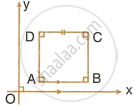Advertisements
Advertisements
Question
Find k, if B(k, –5), C (1, 2) and slope of the line is 7.
Solution
Slope of the line BC is 7.
Slope of BC =
\[\frac{y_2 - y_1}{x_2 - x_1} = \frac{2 - \left( - 5 \right)}{1 - k} = 7\]
\[ \Rightarrow \frac{7}{1 - k} = 7\]
\[ \Rightarrow 1 - k = 1\]
\[ \Rightarrow k = 0\]
APPEARS IN
RELATED QUESTIONS
Find x, if the slope of the line joining (x, 2) and (8, −11) is `−3/4`.
The side AB of a square ABCD is parallel to the x-axis. Find the slopes of all its sides. Also, find:
- the slope of the diagonal AC.
- the slope of the diagonal BD.

Plot the points A(1, 1), B(4, 7) and C(4, 10) on a graph paper. Connect A and B and also A and C.
Which segment appears to have the steeper slope, AB or AC?
Justify your conclusion by calculating the slopes of AB and AC.
Find the slope and the inclination of the line AB if : A = `(-1, 2sqrt(3))` and B = `(-2, sqrt(3))`
Lines 2x – by + 5 = 0 and ax + 3y = 2 are parallel to each other. Find the relation connecting a and b.
The ordinate of a point lying on the line joining the points (6, 4) and (7, –5) is –23. Find the coordinates of that point.
Find k, if PQ || RS and P(2, 4), Q (3, 6), R(3, 1), S(5, k).
Determine whether the given point is collinear.
A (0, 2), B (1, -0.5), C (2, -3)
Determine whether the given point is collinear.
L(1,2), M(5,3) , N(8,6)
Show that points P(1, –2), Q(5, 2), R(3, –1), S(–1, –5) are the vertices of a parallelogram.
Find the slope of the diagonals of a quadrilateral with vertices A(1, 7), B(6, 3), C(0, –3) and D(–3, 3).
Find the slope of a line, correct of two decimals, whose inclination is 50°
Find the slope of a line, correct of two decimals, whose inclination is 75°
Find the slope of a line parallel to the given line x +3y = 7
Find the Slope of the line having inclination 45°.
Write the equation of a line passing through the point P (0,6) and having slope 6/7.
Determine whether the following points are collinear. A(–1, –1), B(0, 1), C(1, 3)
Given: Points A(–1, –1), B(0, 1) and C(1, 3)
Slope of line AB = `(square - square)/(square - square) = square/square` = 2
Slope of line BC = `(square - square)/(square - square) = square/square` = 2
Slope of line AB = Slope of line BC and B is the common point.
∴ Points A, B and C are collinear.
